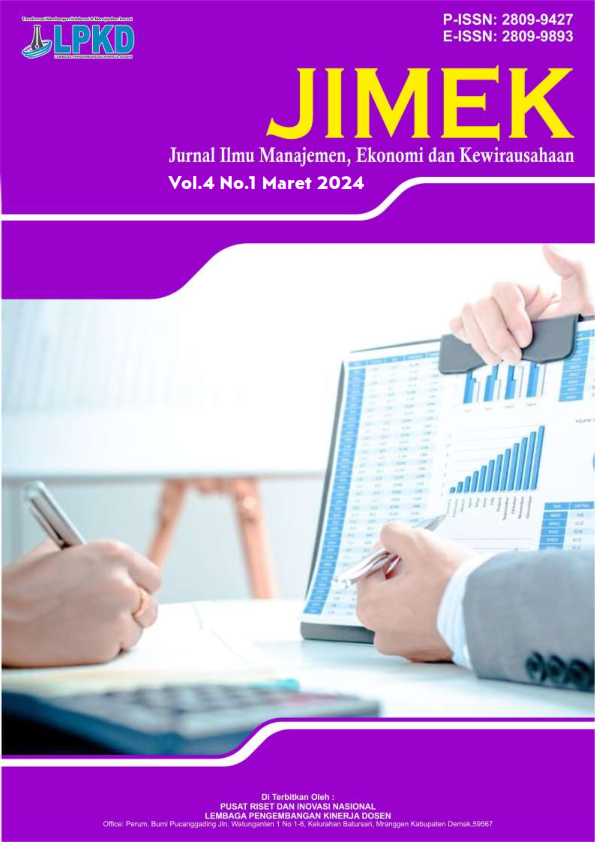Strategi Peningkatan Produktivitas Bongkar Muat dengan Sistem Digitalisasi Electronic Rubber Tyred Gantry (E-RTG) di PT. Terminal Petikemas Nilam Surabaya
DOI:
https://doi.org/10.55606/jimek.v2i1.5893Keywords:
E-RTG, Productivity, Strategy, Loading-and-Unloading, Container-TerminalAbstract
This research aims to explore strategies to improve the productivity of loading and unloading activities at PT. Terminal Petikemas Nilam Surabaya through the implementation of the Electronic Rubber Tyred Gantry (E-RTG) system. Although the E-RTG system has not yet been implemented at PT. Terminal Petikemas Nilam Surabaya, its application is considered a potential solution to support efforts in enhancing loading and unloading productivity. E-RTG is a container handling equipment that utilizes sensor technology and battery-powered electricity as a replacement for conventional fuel. This study employs a qualitative approach with data collection techniques including interviews with RTG operators and the HSSE team, as well as documentation. The data analysis method used is SWOT analysis to identify the strengths, weaknesses, opportunities, and threats associated with the E-RTG system. The research findings indicate that the implementation of E-RTG has the potential to significantly improve loading and unloading productivity. To ensure successful implementation, PT. Terminal Petikemas Nilam requires several strategies such as infrastructure development, human resource training, seeking investment, and updating the port's digital security systems. With proper strategic planning, the implementation of E-RTG is expected to assist PT. Terminal Petikemas Nilam in future adoption efforts and contribute to increasing the productivity of loading and unloading operations at Terminal Petikemas Nilam Surabaya.
References
Amrullah, R. A. (2020). Pelabuhan dan serba-serbinya (bisnis, jasa & fasilitas) (pp. 7–8). Google Books.
Ding, Y., Yang, Y., Heilig, L., Lalla-Ruiz, E., & Voss, S. (2021). Deployment and retrofit strategy for rubber-tyred gantry cranes considering carbon emissions. Computers and Industrial Engineering, 161(April), 107645. https://doi.org/10.1016/j.cie.2021.107645
International Organization for Standardization. (2022). ISO/IEC 27001:2022 – Information security, cybersecurity and privacy protection — Information security management systems — Requirements. https://www.iso.org
Minh, N. Q. (2023, November). Readiness assessment for smart port: Capacity building workshop – Viet Nam I. Legal Area.
Modul praktikum jasa dan fasilitas pelabuhan - Romanda Annas Amrullah - Google Buku. (n.d.). https://books.google.com
Nisa, K. (2024). Pelabuhan Tanjung Perak: Sejarah, fasilitas, dan peran strategisnya. Troben.id.
Pelindo. (2024). PT Pelindo Terminal Petikemas. Pelindo Place Office Tower.
Pelindo. (n.d.). LearningCenter – Training new RTG / RMGC operator. https://pelindo.co.id
PEMA. (2021). Battery & charging solutions in ports: 8th annual crane survey. (Original work published May 2019).
RelyOn Nutec. (n.d.). Case study: Simulation solutions for a major port terminal operator. https://relyonnutec.com
Rosta, B. (2023, December). The profitability analysis of the integration of battery energy storage systems into industrial cranes.
Rubber tired gantry crane market size, share 2025–2033. (n.d.). https://www.example.com
RUSI Europe. (2023). CRIMSON III – Cybersecurity in maritime critical infrastructure: Reflection on African ports. https://rusi.org
Septian, D. (2024). Repositori STIAMAK Barunawati Surabaya. https://repository.stiamak.ac.id
Yang, Y. C., & Chang, W. M. (2021). Impacts of electric rubber-tired gantries on green port performance. Research in Transportation Business and Management, 8, 67–76. https://doi.org/10.1016/j.rtbm.2013.04.002
Downloads
Published
How to Cite
Issue
Section
License
Copyright (c) 2025 Jurnal Ilmu Manajemen, Ekonomi dan Kewirausahaan

This work is licensed under a Creative Commons Attribution-ShareAlike 4.0 International License.








